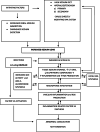To Curb the Progression of Fatal COVID-19 Course-Dream or Reality
- PMID: 33638064
- PMCID: PMC7910199
- DOI: 10.1007/s11906-021-01130-z
To Curb the Progression of Fatal COVID-19 Course-Dream or Reality
Abstract
Purpose of review: To analyze the impact of sodium retention states on the course of COVID-19 and propose possible interventions to curb disease progression.
Recent findings: Numerous data confirm a positive association of non-communicable diseases, aging, and other sodium-retaining states, including iatrogenic ones, with more severe sometimes fatal clinical course of COVID-19. Reasons for this effect could include increased angiotensin signaling via the AT1R receptor. The endothelial glycocalyx also plays an important role in infection, leading to a vicious cycle of inflammation and tissue sodium retention when damaged. RAS inhibitors may help restore glycocalyx function and prevent severe organ damage. Anticoagulants, especially heparin, may also have therapeutic applications due to antithrombotic, anti-inflammatory, glycocalyx-repairing, and antialdosteronic properties. The ambiguous influence of some diuretics on sodium balance was also discussed. Abnormal sodium storage and increased angiotensin-converting enzyme activity are related to the severity of COVID-19. Inducing sodium removal and reducing intake might improve outcomes.
Keywords: ACEI/ARB; COVID-19; Glycocalyx; Heparin; Spironolactone.
Conflict of interest statement
The authors declare that they have no conflict of interest.
Figures
References
-
- Zhou F, Yu T, Du R, Fan G, Liu Y, Liu Z, Xiang J, Wang Y, Song B, Gu X, Guan L, Wei Y, Li H, Wu X, Xu J, Tu S, Zhang Y, Chen H, Cao B. Clinical course and risk factors for mortality of adult inpatients with COVID-19 in Wuhan, China: a retrospective cohort study. Lancet. 2020;395:1054–1062. doi: 10.1016/S0140-6736(20)30566-3. - DOI - PMC - PubMed
-
- Petrilli CM, Jones SA, Yang J, Rajagopalan H, O'Donnell LF, Chernyak Y, Tobin K, Cerfolio RJ, Francois F, Horwitz LI. Factors associated with hospitalization and critical illness among 4,103 patients with COVID-19 disease in New York City. medRxiv 2020; : 2020.04.08.20057794. 10.1101/2020.04.08.20057794 - PubMed
-
- Targoński R, Sadowski J, Price S, Targoński R. Sodium-induced inflammation—an invisible player in resistant hypertension. Hypertens Res e-pub ahead of print 2020; 10.1038/s41440-020-0428-y. - PubMed
Publication types
MeSH terms
Substances
LinkOut - more resources
Full Text Sources
Other Literature Sources
Medical
Research Materials


